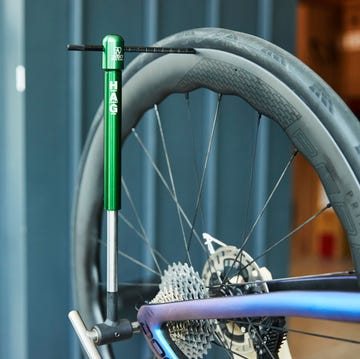TrainerRoad started as an indoor cycling app that would give you a training plan. It has no fancy graphics or avatars, no group rides—just old-fashioned pedaling while watching Netflix on the trainer. But in the decade since the app launched, it’s evolved into a more sophisticated plan-builder, and not only maps out your workouts, but it can also control your indoor trainer. Most recently, the app has even integrated AI so it can adapt your training to your goals, based on metrics from your indoor rides.
You might assume that TrainerRoad is a small offshoot of one of the bigger tech companies in cycling like TrainingPeaks, Zwift, or Wahoo, but Jonathan Lee, communications director at TrainerRoad and a cycling coach, explains that the 11-year-old company remains bootstrapped. Since starting in 2012, the company has grown to around 100 employees—most of whom are avid cyclists themselves. Now, the app has more than 17,000 ratings in the iTunes store, many of which have five-star reviews.
To help you figure out if you should hop on TrainerRoad this season, we’re diving into all of the ins and outs of the innovative app that’s making the most of AI to perfect its training algorithms.
A Quick Look at the Pros and Cons of TrainerRoad
Pros:
• At $19.95/month or $189/year for unlimited training plans, AI-based coaching, and indoor ride support, it’s a good deal
• Compatible with most Bluetooth Smart and ANT+ sensors, including heart rate monitors, power meters, speed/cadence sensors, and smart trainers
Cons:
• Can be a tricky interface to get used to if you’re new to data
• For best results, you definitely need gear like a heart rate monitor and/or a power meter
How does TrainerRoad work?
The most important part of the app is the automated Training Plan Builder. Once you sign up and get started, it prompts you to enter key races in your season, how much time you have to train, and a few other basic details—then, voila! You get a training program. (TrainerRoad supports plans for all types of rides, including road, gravel, fondos, triathlon, MTB and cyclocross, and supports general fitness goals in addition to race goals.)
Signup only takes a few minutes, and the platform offers a 30-day money back guarantee. The biggest time suck is just syncing your various devices (Garmin, Wahoo, Apple Watch, smart trainer, power meter, etc) to the app.
Once you have your training plan, it’s time to get to work. (FYI, if you don’t have a goal in mind, you can always use their TrainNow option, which provides a workout based on your past training, but doesn’t plan out your schedule in advance.)
Workouts in the app are based on power. If you don’t have a power meter on your bike or trainer, TrainerRoad uses VirtualPower, which estimates your output based on speed. You can also opt to use rate of perceived exertion (RPE) for your workouts.
While the platform was originally created for indoor training, it now supports outdoor rides too. Once the app syncs to your cycling computer, you’ll be able to import outdoor rides into your training dashboard and they’ll be recorded.
But indoor workouts are really where the app shines, thanks to the Adaptive Training AI that’s used to analyze your performance. This feature takes into account your objective performance metrics and your subjective feedback, and tweaks the next workout accordingly.
“Our adaptive training AI tool analyzes your training, and then it’s able to give you credit for what you did and say, ‘Okay, based on this input, your next workout should be this and that will get you closer to your goal, whether that’s recovery or something more productive,” explains Lee.
“We’re to the point where we have more than 250 million workouts completed by our athletes, workouts where we know what they should have been doing every second along the way, we know how difficult that workout should have been for them, and we know what they actually did,” Lee adds. “That data trains our artificial intelligence.”
Don’t worry: Adaptive Training will make changes to the next workout, but it won’t change things like the time you have available to train. For example, while it might realize you’re strong enough now to do a four-hour ride on the weekend, if you only input two hours of availability, it won’t extend your ride time.
“It’s constantly looking at how you performed versus how you were prescribed to perform. And because of that, it’s trained on failure data, basically,” adds Lee. “It’s able to see when you come up short, and it’s also trained to see when you are exceeding your goals.”
If you’re doing an indoor workout, the app will connect to your smart trainer and create a dashboard, showing you details like time, power, target power in that interval, and how much time is left in your interval. In ERG mode, your smart trainer will also use the workout inputs from TrainerRoad to automatically adjust your riding, increasing and decreasing resistance as you go. (If you have a dumb trainer and a power meter, you’ll have to handle your own shifting as needed to follow along with the workout prescription.)
TrainerRoad’s workout analysis and how it uses that information make up the major selling features of the app. In addition to the Adaptive Training adjustments, it will create your next workout based on how the current one went, it also automatically adjusts your Progression Levels for each training zone (like endurance, aerobic, tempo, threshold, etc).
While TrainerRoad has AI FTP Detection, the Progression Levels allow for more targeted improvements in specific areas. Improving your FTP isn’t always the way to get faster. For example, if you’re getting ready for your first 200-mile gravel grinder, you’re going to want to see bigger improvements in endurance and tempo rather than in your higher-end power.
TrainerRoad Glossary
While TrainerRoad tries to keep their training metrics as simple as possible, there are a few terms that get tossed around:
Adaptive Training: TrainerRoad’s AI that analyzes indoor workouts and tweaks training based on your objective and subjective data.
Progression Level: These levels, found on your TrainerRoad dashboard, reflect your current abilities and training progress in different training zones (endurance, tempo, sweet spot, threshold, VO2 Max, anaerobic, and sprint). They’re updated automatically.
AI FTP Detection: After 10 indoor rides, your FTP (functional threshold power) is estimated by TrainerRoad’s AI, which constantly adjusts based on your workout input.
What else does TrainerRoad do?
➥ Guide your indoor workouts on another platform
If you’re looking for a virtual world to ride in, TrainerRoad isn’t the answer. However, it can be used in conjunction with Zwift. Both apps can run simultaneously on your phone or tablet while you’re doing your indoor training ride
You can elect to just use the TrainerRoad app to guide your workout on your smart trainer or with your power meter while watching TV or listening to music.
➥ Figure out your FTP without testing
If you’re someone who really, really loathes doing FTP tests on the bike, TrainerRoad has your back. The company uses AI to calculate your FTP based on 10 indoor rides. According to the founders, the AI uses millions of workouts and nuggets of data from TrainerRoad users in order to reliably predict your FTP—no 20-minute test required. And it continues to monitor your predicted FTP, so you can easily see the direction your power is trending.
➥ Look ahead in your training calendar
On your TrainerRoad dashboard, you can easily access the calendar view to see upcoming workouts, and move things around as needed when life gets in the way.
Are there any downsides to TrainerRoad?
The major downside of TrainerRoad is that right now, the AI adjustments are only made based on indoor workout data, not outdoor rides, runs, or added workouts like strength training. It also takes 10 indoor rides before the AI can start calibrating, so if you don’t regularly ride the trainer, it could take a while before the AI will really work for you.
In other words, while TrainerRoad can take into account that extra-hard session you did in the pain cave on Wednesday in your basement, it won’t have any idea about that hike you added on Friday morning. But they’re working on it!
As with any coaching-based company, there will be arguments over training ethos: Some critics say that the plans created by TrainerRoad weigh too heavily on high-intensity training, but every coaching company will have a particular leaning. The plans are extremely customizable, so you can always opt to dial down intensity when/if needed—and with the addition of AI Adaptive Training, TrainerRoad claims that it has no coaching philosophy constraints.
Finally—and it’s hard to call this a downside, exactly—but TrainerRoad is not a living, breathing cycling coach. You can’t get that for under $20 per month. “There are a lot of cyclists who just want the workouts and they don’t need the human connection,” says Lee. “They have a support group in their friends or family or something else, and they don’t want a coach. That’s where we fit in.”
If you’re looking for human interaction or need that IRL accountability to keep you going, though, TrainerRoad doesn’t provide the same level of humanity that a coach.
That said, Lee points to many athletes on the platform who work with outside coaches to check over their training, tweak it as needed, and hold them accountable. And there are plenty of coaches on staff and active in the TrainerRoad forum if you do have questions.

Molly writes about cycling, nutrition and training with an emphasis on bringing more women into sport. She's the author of nine books including the Shred Girls series and is the founder of Strong Girl Publishing. She co-hosts The Consummate Athlete Podcast and spends most of her free time biking and running on trails, occasionally joined by her mini-dachshund.













